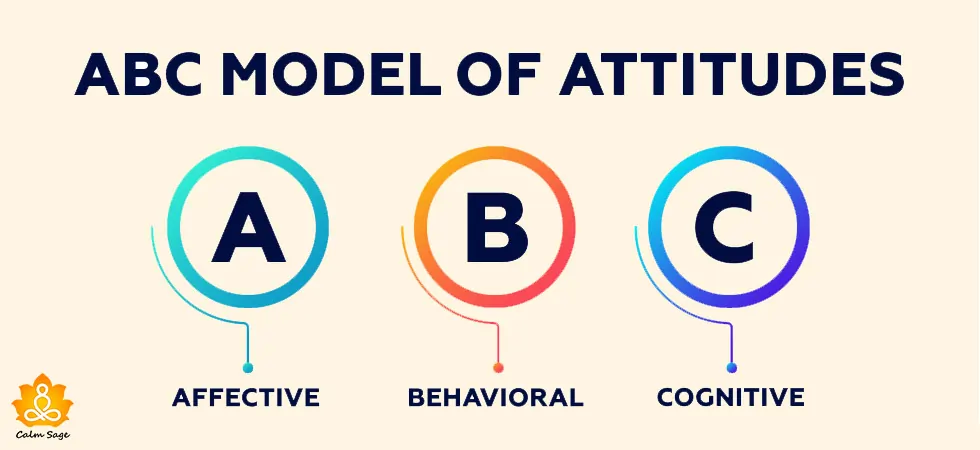3 Components Of Attitude In Psychology

To keep it short and crisp, attitude is an organization of behaviors, feelings, beliefs, and tendencies towards significant events, objects, groups, or anything. Have you ever wondered what shapes our attitude? The main components of attitude in psychology are affective, behavioral, and cognitive.
This model of attitude is known as the ABC model of attitudes or the tri-component model. This blog covers the three components of attitude, how attitude shapes our personality, and more. So, let’s get started!
What is Attitude?
Attitude in psychology is a complex concept as various psychologists have shown different aspects of attitude. Below are some of the famous and influential definitions of attitude given by psychologists:
- Gordon Allport: Attitude is a neural and mental state of readiness, attitude is organized by experiences that exert a dynamic and direct influence on people related to situations, objects, people, and other concerning factors.
- Kurt Lewin: Attitude is a way of representing self towards an object, situation, people, or concerning factors based on personal experiences (be it negative or positive).
- Abraham Maslow: Attitude is an emotional and mental shorthand reflection or opinion about anything.
What are the Three Components of Attitude?
The three main components of attitude are: Affective, Behavioral, and Cognitive also known as the ABC model of attitude. Let’s take a deep look at the components of attitude:
Affective Component
The affective component of attitude includes emotions or feelings related to the attitude object. It basically refers to the emotional feelings or reactions people provide towards an object, issue, situation, person, or anything.
For example, “I hate working for eight hours.” The affective component of attitude usually describes emotional responses such as hate, fear, dislike, like, love, and others. In psychology, the affective component is known for influencing behaviors.
For example, suppose someone feels happy after meditating, they may state, “I feel happy and healthy after meditating”, this shows an effective response towards meditating, and this might also be a sign that they are going to develop the habit of meditating regularly.
Or, suppose someone is afraid of driving cars, they may state, “I hate driving a car” (Affective Component), now in response to this statement you will see them travel through public transport (Cognitive Component).
Behavioral Component
The behavioral component of attitude describes people’s behaviors or responses towards a person, issue, situation, object, or anything based on their attitude. The behavioral component of attitude makes people behave in a certain manner in response to the affective component.
For example, suppose you’re keen on meditating regularly, in response to this statement you might meditate regularly because it keeps you light, healthy, and positive. In short, our behaviors describe how we react in a certain situation based on our attitude.
Cognitive Component
The cognitive component of attitude describes our attributes, thoughts, and beliefs toward a specific situation, object, person, or anything. It also describes our interpretation, understanding, and reflection of the information. For example, a person is afraid of snakes and they state, “I don’t like snakes.”
He/she might stop visiting places or situations that involve snakes. This represents the cognitive component in order to prevent themselves from the triggers. The cognitive component of attitude influences how we react and engage the next time. Herein, knowledge acts as the main character in describing the cognitive part.
What are the Strengths of Attitude?
The strength in attitude acts as the predictor of our behavior. You might have heard, “The stronger the attitude, the higher the effect will be.” This statement pretty much sums up why attitude requires strength. Attitude strength in psychology includes:
- Personal relevance: It shows how significant the attitude is for an individual. Personal relevance relates to social identification, self-interest, and value.
- Knowledge: The knowledge aspect of strength revolves around how much an individual knows about their attitude towards an object, situation, place, or anything. This describes their positive or negative attitude induced by a consequence.
How Attitude is Formed?
Attitude in psychology is known to be formed by various processes and factors such as:
1. Social experiences:
Early, familial, group, and individual experiences from childhood to adulthood play an important role in the formation of attitude. Learned values, beliefs, and experiences shape attitude.
2. Direct experiences:
Personal experiences gained by certain situations, people, or objects shape attitude highly. The nature of experience (positive or negative) plays an important role in the formation of positive and negative attitudes.
3. Cognitive processes:
Cognitive processing such as evaluation of information, reasoning, and critical thinking also plays an important role in the formation of attitude. Dissonance theory in psychology suggests that people try to maintain consistency between behaviors and attitudes, and this brings a consistent change in the attitude depending on the consequences and actions of concerned factors.
4. Emotional Influences:
Emotional reactions towards a situation, object, person, or anything shapes our attitude. For example, traumatic experiences might lead to strong negative reactions such as hate, triggers, fear, and more. Meanwhile, happy or positive experiences might lead to strong positive reactions such as happy, cheerful, positive, and others.
5. Societal and Cultural Influences:
Societal expectations, values, and cultural norms also influence attitude. This can also cover our opinions towards gender roles, politics, religion, justice, mass media, social media, and others.
6. Educational Sources:
Attitudes are highly influenced by our schooling, educational material, knowledge, and others.
How Attitudes Can Be Changed?
A lot of people on the internet asked if they can change their attitude or not. The answer is yes, attitude can be changed. Here’s how you can work on changing your attitude:
1. Gain new understanding or information:
In order to change a negative attitude to a positive one, it’s important to gain the right and credible information related to the situation.
2. Ask open-ended questions:
In order to satisfy your emotions and logic, take the help of open-ended questions, explain your narrative, use the data, and talk on the basis of credible information.
3. Think about norms:
Before adopting an attitude, think about your values and norms. If it’s acceptable, align your emotions accordingly.
4. Accept your emotions:
Emotions play an important role in the formation and destruction of an attitude, therefore, understand your emotions and change your attitude.
5. Think critically:
Critical thinking leads to more evaluation and assessment of knowledge, therefore, engage in critical thinking, and fact-check everything.
6. Create positive associations:
In order to change a negative perspective to a positive one, take the help of positive emotions.
Frequently Asked Questions
I hope this blog helps you understand the components of attitude and more about attitude from the lens of psychology. For more such content, connect with us through all social media platforms.
Thanks for reading!




















